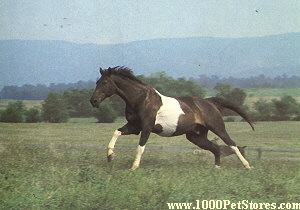Among the 16 horses brought to Mexico by Cortes in 1519, according to the expedition's historian there was 'a pinto with white stockings on his forefeet' and 'a dark roan horse with white patches'. These were the first multi-colored horses to come to North America. Indians were particularly attracted by the painted horses ('pinto', from the Spanish word for 'painted', is used interchangeably with 'Paint', although the latter word properly describes the breed, and 'pinto', a type). They thought colorfully-marked horses had magic properties which would make a brave invincible in battle. The Cheyennes and Comanches, for example, favoured 'Medicine Hat' -mustangs boldly splashed with color on the head and chest.
Although Paint horses could have suffered the same decline as the mustangs, Wild West shows come to their rescue. Eastern audiences love the spectacle of cowboys and Indians, usually riding Paints, galloping around indoor and outdoor arenas.
Its distinctive coloration apart, the Paint Horse closely resembles and Quarter Horse, with a clean head, fairly long neck, deep chest, short backline and long croup, and straight, clean legs. There are two types of body coloration, overo and tobiano. An overo gives the impression of being a dark horse splashed from underneath with white, while a tobiano is predominantly white with dark markings. The markings can be brown, black, or roan.
The reason for the Paint's resemblance to the Quarter Horse is often no accident, since a Paint can have a sire or dam of that breed. Hence the great speed in Paint racing horses; times of under 12 seconds for 220yds and under 20 seconds for 350 yards are not uncommon.
Some of the great Paint Horses of the past had names that come out of the American West: The great racer Painted Joe, a cutting mare called Calamity Jane, Wahoo King, and Mr. J Bar, suggestion ranch's brand. The Paint's vesatility is shown in such Western events as barrel-racing (galloping clover-leaf patterns around three barrels), as well as pole bending, calf roping, and reining classes, the Western equivalent of dressage. In addition, they compete in English hunter, jumping and equitation classes recognized by the American Paint Horse Association, established in 1961.

PAINTS
www.apha.com American Paint Horse Association